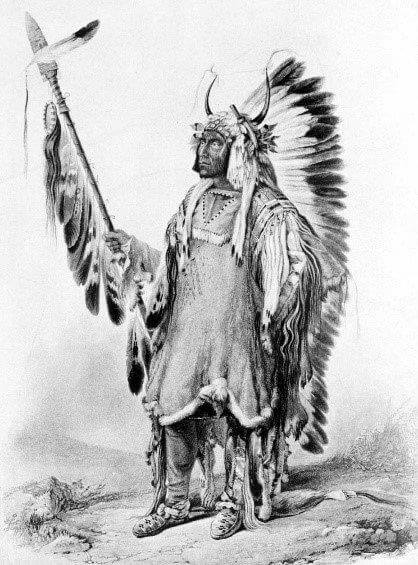
Mandan Chief Four Bears. The Mandan Chief called Four Bears grew up along the Knife River near present-day Stanton, North Dakota. He received his name after a battle in which the other warriors said he fought like four bears. Photo SHSND C0597.
Most of the people in North Dakota were nomadic or semi-nomadic until about 1100 A.D.
Archaeological evidence tells us that by then, some lived in permanent homes in fortified villages and became sedentary.
The people we know today as the Mandans moved into ND around the year 1000 A.D. By 1100, they had settled in several villages along the Missouri, Heart and Knife rivers. They were still living there in the 19th century.
They gathered in villages and built permanent houses and are known as sedentary tribes. Along their journey to this location, they learned about corn and how to grow it.
Other People continued to move around, usually following bison herds.
Because these people migrated to find game and plant foods, they lived in housing that could be easily packed up and taken with them, or they built shelters whenever they settled down for a little while. They might have moved 12 to 20 times a year.
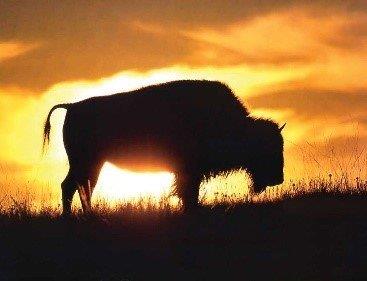
The buffalo were sacred and critically important to the Plains Indians because they provided food, clothing, shelter and many other necessary and religious items for them. Photo www.FirstPeople.us.
They probably traveled more during summer and fall when it was important to find game and plants to preserve for winter. Likely they moved less often in winter.
As the People made changes in their lives, they continued to remember their past and told the stories to their children. Every group of people has a story about where they came from and how they were created. The Bible and Koran tell of the Creation.
These stories came to be known as origin stories. They help us to reach back into the past to learn more about the earliest residents.
Many of the Dakota stories include buffalo because of their importance in the Native culture.. Some groups have more than one origin story.
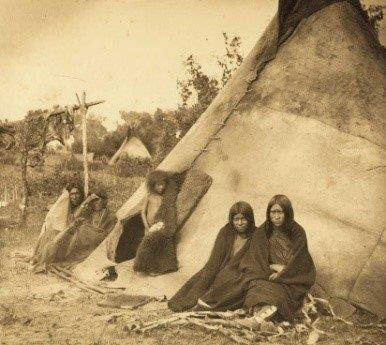
This family poses for a photo next to their tipi home. The tipi is made of tanned bison hides. In the background, notice the meat drying. SHSND 0014-033.
We can learn a lot about the culture of the People and what qualities they thought were important by reading or listening to their origin stories.
The earliest People to come to ND had creation, or origin, stories. Some of these stories have been preserved through oral tradition. Oral tradition means telling stories about the creation to others, especially the children.
Most of the origin stories are very complicated and very long. There are many characters and many events. The stories are important today because they tell us about the spiritual beliefs and cultural traditions of the People.
Origin stories give us one view of how people came to live here. The stories were handed down from parents to children for centuries. We don’t know what people called themselves when they began telling these stories, but over hundreds of years, they came to call themselves Hidatsa, or Lakota, or Chippewa or another name.
Origin stories tell of some of the great struggles the people went through to emerge on the earth and become fully human.
They had to learn many things and organize into well-ordered communities. They had to learn to understand supernatural powers as well as the natural powers of the plants, animals, rocks and climate.
It is important to remember that some of these stories should be told only at a certain time of the year or under certain conditions.
Since we cannot always meet those conditions when we read the stories, we need to remember to be thankful that the stories have been recorded for us to read and be respectful of the spirit of the people who told these stories over the generations.
The Hidatsa
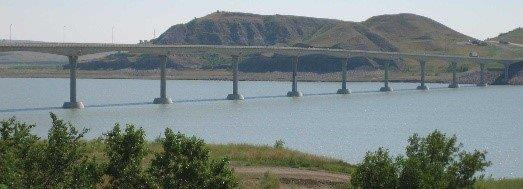
The new Four Bears Bridge is located at New Town, ND. It was completed and dedicated in 2005. Photo Neil Howe.
The Hidatsa have three different origin stories because they believe long ago, there were three different groups of people who eventually came together to become the Hidatsa.
The people established 13 villages along the Missouri that eventually became the 13 clans of the Hidatsa.
The Awatixa (ah wah TEE ha) believed that they were created on the shores of the Missouri River by the great hunter Charred Body, who brought the Awatixa (“People of the Village of the Scattered Lodges”) to Earth.
The Awaxawi (ah wah HAH wi) climbed to the surface of the earth by climbing up a vine.
These “People of the Village on the Hill” lived east of the Missouri River and raised crops until they migrated to the Missouri River and joined the Awatixa and Hidatsa-proper.
The Hidatsa-proper—“People of the Willows”—emerged from the earth near a large lake (often identified as Devils Lake).
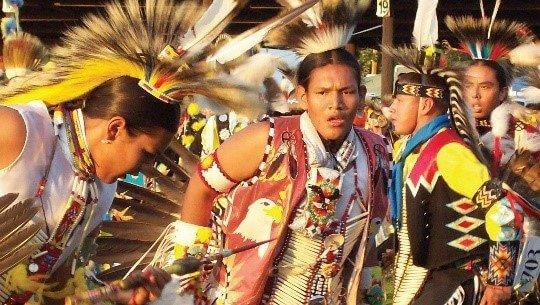
The powwow is the oldest public festival in North America. Photo Gwyn Herman
They climbed up a vine and emerged through a hole onto the surface.
Tragically, a pregnant woman got stuck in the hole and prevented more people from climbing up the vine. The pregnant woman stopped the migration so there are still Hidatsa ancestors under the earth.
The Hidatsa-proper migrated around the Great Plains until they came to the Missouri River. Here they met the Mandans who helped them cross the river to the west bank.
The Mandans gave the name “Minitaree” or “Cross the Water” to the Hidatsas. Once they arrived at the Missouri River, the Hidatsa-proper learned how to grow corn from other people.
The Mandans

Tchung-kee was a popular sport with the Mandan and Hidatsa boys and men. These stones are on exhibit at the Knife River Villages National Historic Site. Photo ND Geological Survey.
The Mandans were created in two events.
First Creator created the land, animals, plants, rivers and hills west and south of the Missouri River.
A spirit being called Lone Man created the flat land, ponds and grasslands east and north of the Missouri River. Lone Man also created cattle, sheep, birds and white People.
First Creator and Lone Man disagreed about some details of creation, but eventually, Lone Man came to live among the Mandans.
The second event took place at the mouth of the Missouri River. There the people lived in a cave.
A young man left the cave and went to the surface. He returned to his people and told them about the land, so the Mandans left the cave, bringing corn and squash with them.
They lived in different places along the Mississippi River, but then returned to the Missouri River where they met the other Mandans.
Lone Man continued to live with the Mandans a long time, but then decided to return to his home, the south wind.
He promised the Mandans that he would return someday and in the meantime, they would always have his help.
Lone Man returns every spring as the warm wind.
The Arikaras
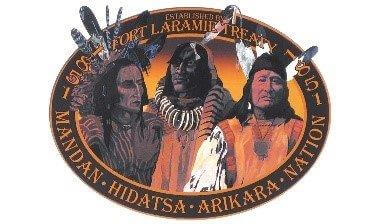
The Three Affiliated Tribes logo. Neil Howe.
The Arikara origin story tells us that long ago the people lived in Mother Earth.
Then, Mother Corn brought all the people out to the world.
At first, the people did not know how to live properly, so they wandered. As they wandered, some of them were made into fish, others into birds, moose, bears and other “animal people.”
Eventually, the Arikaras found a land (in modern Nebraska) that had everything they needed to live. Here, Mother Corn came to them and taught them how to live on earth and how to pray to Man Above.
Mother Corn died, but she left the corn plant to remind the Arikaras of her love for them.

The bullboat was made from the hide of a bison bull stretched over a willow frame. The round bullboat provided a way of transportation on the Missouri for the Mandan, Hidatsa and Arikara people. Photo Fort Abraham Lincoln Foundation.
Many years later, the Arikaras moved north to live along the Upper Missouri River.
The Dakotas
The Dakotas tell of coming from across the ocean where they had lived in the land of cold winter and much ice.
They crossed the ocean in boats. When they landed, they found a place where there was plenty of game and other things they needed.
They migrated westward and met the Chippewas in a place where there were three large lakes. While they lived there, white people came, bringing metal tools.
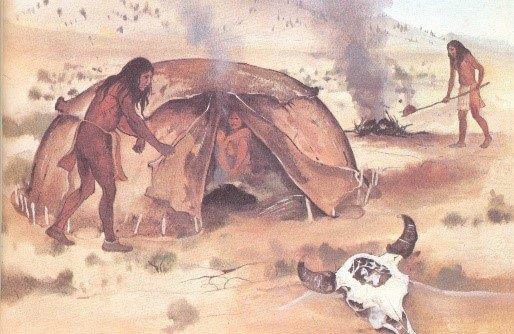
Sweat Lodges were used as baths, or to purify the body, mind and spirit. A frame of willow, covered with bison hide, was set up over a fireplace. Red-hot rocks were put in the fireplace, and water was poured over them, making the lodge a hot, dark, steam room. Photo Christopher Davis.
These tools caused trouble for the Dakotas with the Chippewas, but the Dakotas drove the Chippewas away.
The Dakotas continued to move west until they reached the Mississippi River Valley where they settled in permanent villages.
The Lakotas
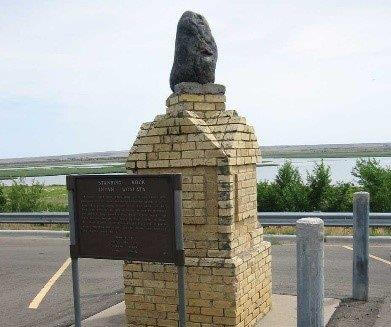
Standing Rock Monument is located near the entrance to the Standing Rock Tribal headquarters in Fort Yates, North Dakota. Neil Howe.
The Lakotas believe that long ago, there were only four people on earth.
One of them was the Trickster, Iktomi. Iktomi tricked Anog-Ite into telling him how to get other people from under the earth.
The people under the earth were six men and their wives and a young man named Tokahe, The First One.
Iktomi invited them to the surface. He told them that the world was full of food, clothing and everything they needed. But Iktomi had tricked them; the people found nothing that they needed.
Anog-Ite’s parents, Waziya and Wakanka helped the people by bringing them food and water. Waziya and Wakanka led the people to the forest and showed them how to hunt and live on the earth.
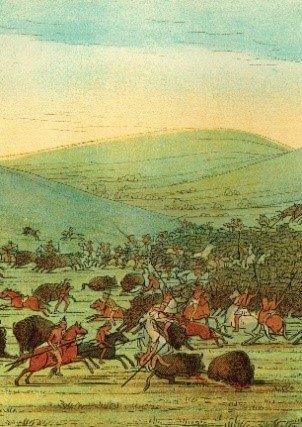
As many as 30 million bison probably roamed the grasslands, prairies and plains of North America. After Native Americans obtained horses in the mid-1700s and could trade for guns, hunting became easier for them. Sketch SHSND 970.1 C289NL.
The people learned well how to live and had children. The children of these people are the Lakotas (Sioux).
The Chippewas
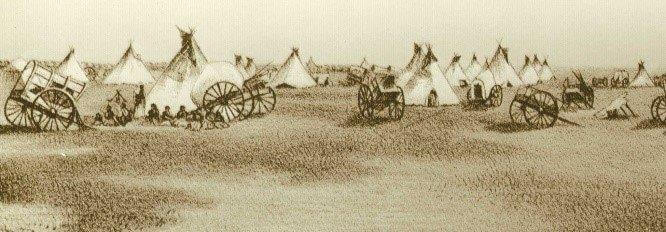
Sketch of a Métis campsite. Notice the Red River carts next to each tipi. SHSND C0621.
The earth, the sun, and the moon were created by the Great Creator, Kitchie Manitou.
Kitchie Manitou also created the plants, rocks, trees, animals, wind and birds. He sent the birds in the four directions (north, south, east and west) to carry life to every place.
Then, when all of the plants and animals had been created, Kitchie Manitou took four parts of Mother Earth and blew into them creating Man.
Kitchie Manitou then lowered Man, the last creation, to the earth. Man considered all of creation his elders because they came before him.
The Chippewa people who descended from Man first lived by a great salt water, a long way east of where they live now in Wisconsin, Minnesota and North Dakota.
For many years, the Chippewas migrated west, always trying to live closer to the place where their Me-da-we religion could be practiced in its purest form. They finally reached the proper place which was La Pointe Island in Lake Superior (the Apostle Islands).
From here, the Chippewas spread in many directions. Some of them migrated into North Dakota, where they lived and hunted between the Red River and the Turtle Mountains
For the earlier 8th grade ND Studies see the following:
https://www.ndstudies.gov/gr8/content/unit-i-paleocene
NEXT: Blog 73-Part 1-North Dakota 8th Grade studies: Raising Corn
______________________________________________________________________________

Francie M Berg
Author of the Buffalo Tales &Trails blog


